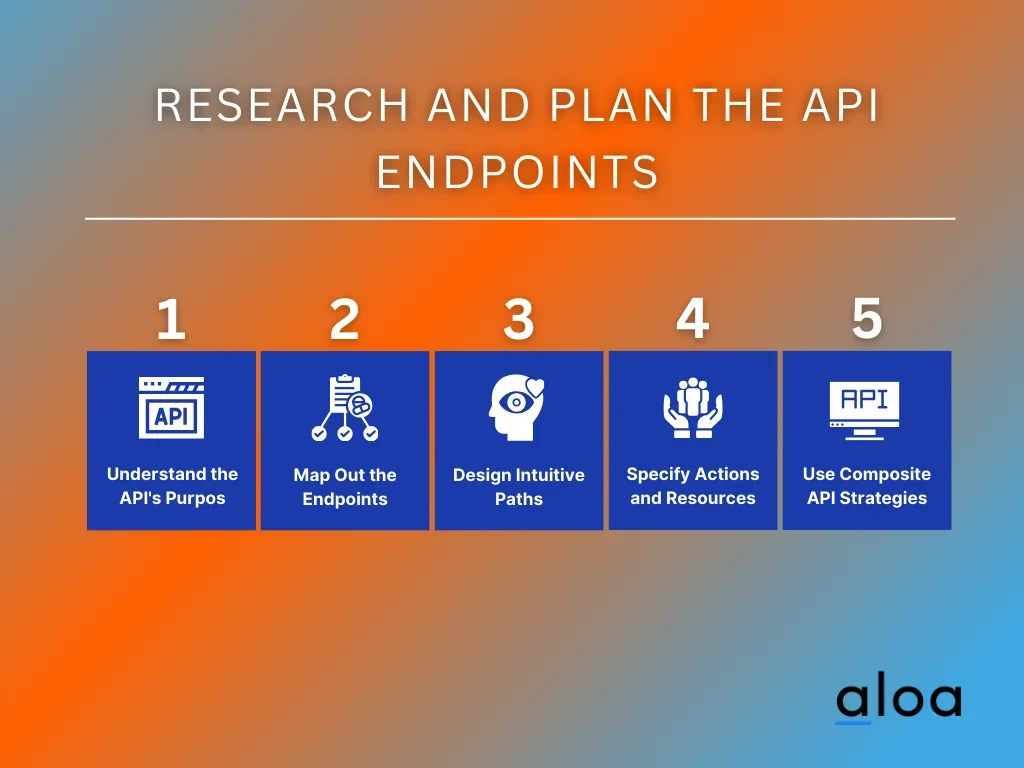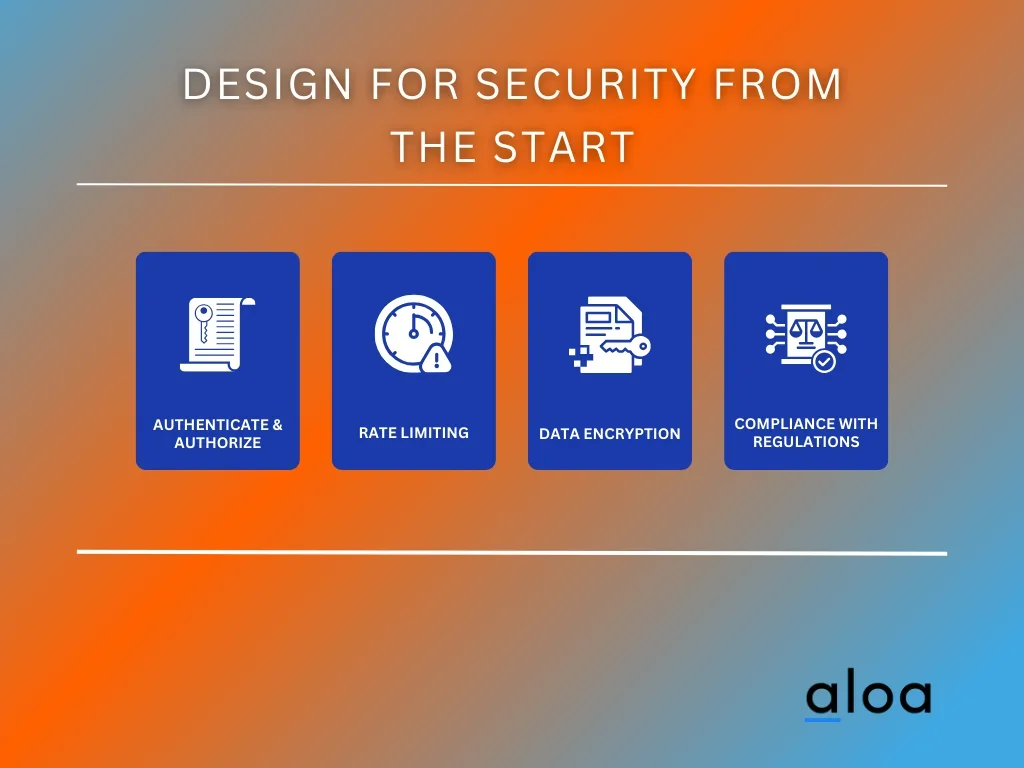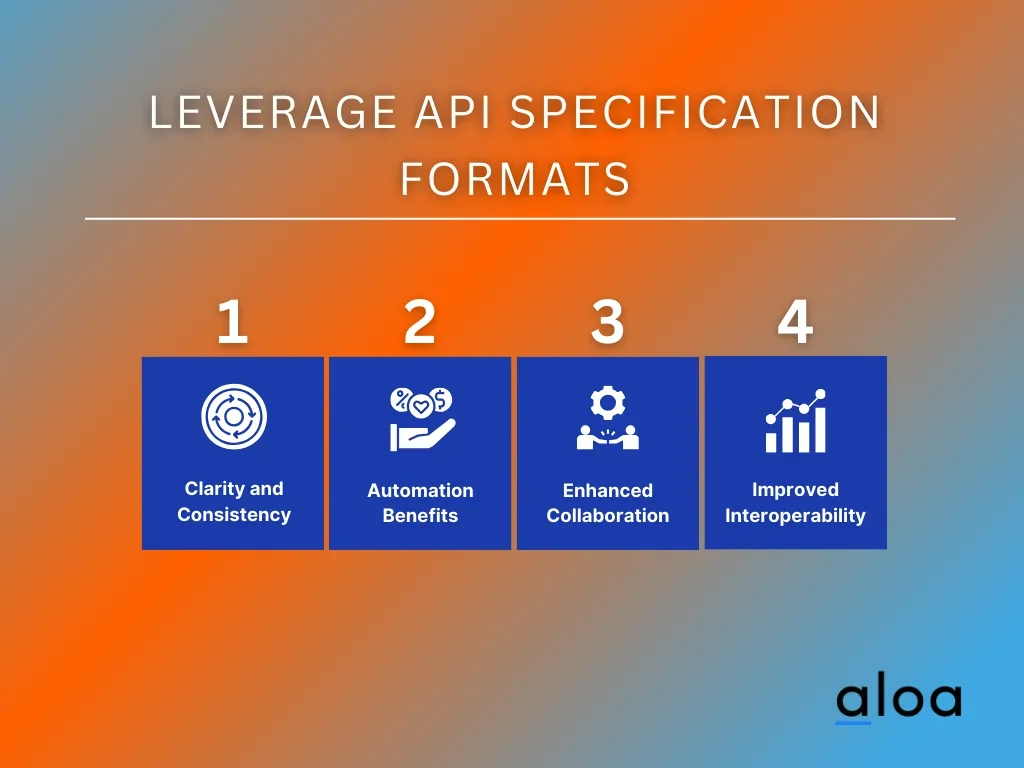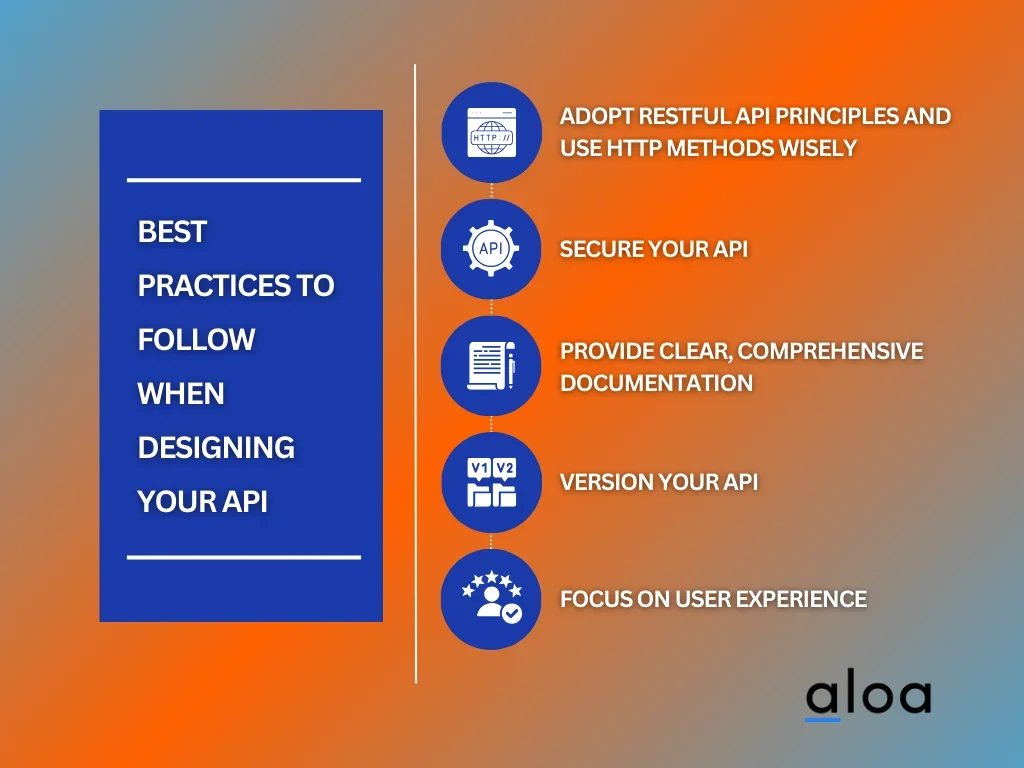In digital ecosystems, the exponential growth of software solutions has highlighted the pivotal role of APIs in enabling seamless integrations. Yet, navigating how to design an API presents common challenges that often hinder scalability and user adoption. These obstacles range from ensuring robust API responses and developer experience to maintaining consistency across different software components.
Aloa, an expert in software outsourcing, helps businesses and startups overcome these challenges. With the latest trends in API development, Aloa ensures that API design prioritizes functionality, security, and a positive developer experience. Their approach ensures that server-side functionalities meet the highest standards of developer experience, emphasizing security for sensitive data and promoting good documentation practices.
This blog will guide you through the essential steps on how to design an API. You'll learn about the significance of best practices when designing API and understand the importance of an API design first approach. Afterward, you will grasp the foundational elements of designing an API that ensures a successful response, caters to the needs of API consumers, and enhances the end-user experience.
Let's dive in!
How to Design an API (Application Programming Interface)
Designing an API is crucial to modern software development, providing the foundation for seamless integration and efficient communication between diverse systems. A well-crafted API ensures seamless integration, scalability, and a positive developer experience. In this guide, we’ll explore vital principles, steps, and practices on how to design an API effectively.
.webp)
Step 1: Define the Purpose and Scope
Understanding how to design an API begins with clearly defining its purpose and scope. This initial step is crucial as it shapes the entire development process, ensuring the API serves a specific, valuable function for its intended users. However, before diving into the technicalities, developers must ask critical questions to pinpoint the API’s objectives, including:
- Who are the primary users of the API?
- What specific problems will the API solve?
- How does the API integrate with existing systems, like composite APIs?
- What are the expected outcomes for users interacting with the API?
- Are there any specific constraints or requirements that need consideration?
These questions help you easily navigate the succeeding steps on how to design an API, preventing feature creep and ensuring that the API remains manageable and relevant. For instance, understanding how it will fetch, merge, and manipulate data from various sources is essential if the API needs to work together with composite APIs. This foresight in planning allows for smoother development phases and more efficient problem-solving strategies.
Step 2: Research and Plan the API Endpoints
Designing an API involves meticulous planning and research, especially when structuring the API endpoints. This foundational phase sets the stage for a robust and intuitive interface with which developers will engage. Here are the things to consider on how to design an API with careful research and planning the API endpoints:

- Understand the API's Purpose: Clearly define what your API aims to achieve. This understanding is crucial for aligning the endpoints with the API's goals.
- Map Out the Endpoints: Create a corresponding endpoint for each function or resource your API exposes. These endpoints are the access points through which users interact with your API, so they must be logical and predictable.
- Design Intuitive Paths: Each endpoint should have an intuitive path that indicates its function. This clarity enhances usability and developer experience.
- Specify Actions and Resources: Detail the actions (GET, POST, PUT, DELETE) each endpoint will support, ensuring they align with the principles of RESTful design or the specific protocol your API follows.
- Incorporate Composite API Strategies: When planning your endpoints, consider using Composite APIs to streamline complex interactions and data retrieval processes, enhancing efficiency and performance.
The process of how to design an API requires a thoughtful approach to planning and structuring endpoints. You can create a robust, user-friendly API by focusing on clear objectives, intuitive naming, precise action-resource mapping, and the strategic use of Composite APIs. Remember, the success of an API is how easily developers can understand, adopt, and leverage it in their applications.
Step 3: Design for Security from the Start
When learning how to design an API, emphasizing security from the beginning is crucial. An API's architecture should incorporate robust security features that safeguard against unauthorized access and data breaches. As developers embark on this critical phase, several vital considerations must guide their approach:

- Implement Authentication and Authorization: Choose reliable mechanisms like OAuth or API keys to verify user identities and control access levels.
- Rate Limiting: To prevent misuse and ensure equitable access, limit how often a user can request within a given timeframe.
- Data Encryption: Use HTTPS to encrypt data in transit, protecting sensitive information from interception.
- Compliance with Regulations: Be aware of and adhere to data protection laws relevant to your users, ensuring your API's compliance with global standards.
The key to designing an API with security at its core is anticipating and mitigating risks before they become issues. Developers can create a more resilient and trustworthy platform by embedding security measures into the API's design. This enhances the API's reliability and builds user trust, a crucial component for long-term success.
Step 4: Implement API Versioning
When you delve into how to design an API, implementing versioning emerges as a critical step. This process is pivotal for the API's lifecycle, ensuring that updates and improvements don't disrupt the existing user experience. Versioning allows your API to evolve without breaking compatibility with applications that depend on it.
Here are critical considerations for effective API versioning:
- Choose Versioning Strategy: Select a versioning strategy that aligns with your API's needs through the URL, headers, or parameters.
- Communicate Effectively: Ensure clear communication with your API's users about any changes or updates.
- Document Comprehensively: Provide comprehensive documentation for each version to facilitate smooth transitions and integration for developers.
This approach to versioning is fundamental to maintaining a robust and flexible API. It respects the needs of developers who rely on your API for their applications, allowing them to adapt to changes on their own terms. Also, adequate versioning strategies indicate a well-thought-out API design process, reflecting foresight and a commitment to long-term usability.
Furthermore, this step on how to design an API safeguards your API's integrity over time while accommodating growth and innovation. Prioritizing versioning in your API design ensures a scalable, future-proof solution that developers can rely on, making your API a dependable component of the digital ecosystem.
Step 5: Focus on User Experience with Documentation
Another pivotal aspect of how to design an API is focusing on user experience, primarily through comprehensive documentation. Effective documentation bridges your API and its users, making it an indispensable tool for facilitating smooth integration. When crafting documentation, consider this actionable guide:
- Illustrate: Provide clear, concise examples of requests and responses to demonstrate how your API works in real-world scenarios.
- Authenticate: Detail authentication methods clearly, ensuring users understand how to access your API securely.
- Clarify: List all possible error codes with explanations so users can quickly troubleshoot issues.
- Structure: Organize documentation logically, making it easy for developers to find the necessary information without searching.
Understanding how to design an API extends beyond the technical architecture to how well you communicate its functionality and value. Prioritizing these elements, you create an environment where developers feel supported and confident using your API. Good documentation clarifies how to use the API and significantly enhances the overall user experience, encouraging wider adoption and more innovative applications of your API.
Step 6: Test and Iterate
The rigorous process of testing and iteration is a crucial phase in designing an API. Before making your API available for widespread use, it's essential to conduct thorough testing to uncover potential issues that could impair functionality or user experience. This step ensures the API operates as intended across various scenarios and use cases. Consider the following when testing your API:
- Automate: Implement automated testing to simulate a wide range of interactions with the API.
- Scale: Test for performance under different load conditions to ensure scalability.
- Secure: Check security vulnerabilities to protect user data and access.
- Compatibility: Ensure compatibility across different platforms and devices.
Additionally, gathering feedback from initial users is invaluable. Their experiences and insights can highlight unforeseen issues and areas for improvement, providing a direct path to enhance the API's effectiveness. This feedback loop facilitates continuous refinement, allowing the API to evolve in response to real-world use and emerging requirements.
Indeed, testing and iterating are crucial steps in how to design an API. They embody the commitment to delivering a robust, user-centric product. This iterative process enhances the API's quality and reinforces its relevance and longevity in the tech ecosystem.
Step 7: Leverage API Specification Formats
Incorporating API specification formats into your design process is a pivotal strategy to streamline development and communication. Adopting standards such as OpenAPI (formerly Swagger) or RAML, enables you to create a detailed blueprint of your API's structure, endpoints, and data models in a format that machines can easily interpret.

This step is integral for several reasons:
- Clarity and Consistency: API specifications serve as a clear contract that outlines exactly how the API is structured and operates. This clarity is invaluable, ensuring everyone, from developers to stakeholders, understands the API's capabilities and limitations.
- Automation Benefits: Utilizing these specifications can dramatically simplify the generation of documentation and client libraries. This automation reduces manual coding efforts, minimizes the risk of errors, and accelerates the overall development process.
- Enhanced Collaboration: When figuring out how to design an API, the importance of team collaboration cannot be overstated. API specifications facilitate better teamwork by providing a unified reference point that all team members can use, regardless of their role in the project.
- Improved Interoperability: By adhering to widely recognized specification formats, your API will more likely be compatible with various tools and technologies. This interoperability is crucial for users who may integrate your API into diverse systems and applications.
Designing an API that meets current needs and is poised for future growth and integration by leveraging API specification formats is a forward-thinking move. It ensures that your API design is not just about creating a functional interface but crafting an ecosystem where developers can easily connect, create, and innovate.
Best Practices to Follow When Designing Your API
Designing an API is a crucial step for developers aiming to ensure their applications interact seamlessly with other software. A well-designed API facilitates efficient communication between different software components, enhancing the user experience and operational efficiency.
Here, we delve into the best practices to follow when designing an API, emphasizing the importance of a systematic approach for startups and businesses.

Adopt RESTful API Principles and Use HTTP Methods Wisely
A good API design begins with choosing a suitable protocol. RESTful APIs, also known as REST APIs that utilize HTTP methods such as GET, POST, DELETE, and PUT, are widely adopted for their simplicity and effectiveness. Ensuring your API adheres to REST principles, including statelessness and resource identification through URL, is a good practice.
However, for each action, ensure to use the appropriate HTTP method. For instance, use GET for data retrieval without affecting the data and POST for creating new resources.
Secure Your API
Security is paramount, starting from the design stage. Thus, implement authentication and authorization mechanisms, like OAuth, to control access and ensure data protection. You may also employ HTTPS to encrypt data in transit, and be meticulous about validating input to safeguard against injection attacks.
For server-side security, ensure that your API only exposes necessary information and uses appropriate status codes to communicate effectively with the client.
Provide Clear, Comprehensive Documentation
Good documentation is the first step to ensuring your API is accessible and easy to use. It should detail available endpoints, supported HTTP methods, expected request bodies, and response formats, preferably in JSON, for its ease of use. Include examples of common requests and responses, and explain error codes to help users troubleshoot issues. Documentation should evolve with your API, reflecting any new API versions or changes.
Version Your API
Introducing a version number in the API's base URL or header ensures backward compatibility and allows users to transition at their own pace. It's a good idea to plan your versioning strategy early and communicate changes clearly to your API users, helping avoid any service disruptions as you iterate some changes and improvements.
Focus on User Experience
Upon designing your API, focus on the end user's perspective to provide an intuitive, easy-to-use interface. Use nouns instead of verbs in endpoint paths for clarity and consistency. You may even optimize response times by allowing filtering, sorting, and pagination through the query string.
Additionally, adopting the Open API Specification can aid in standardizing and validating your API design, making it easier for both API designers and users to understand the structure and capabilities of your API.
Importance of an API Design First Approach
In software development, adopting an API design-first approach proves to be a pivotal strategy for ensuring the success of a project. This methodology emphasizes crafting a comprehensive plan for the API before actual implementation begins.
Let's explore five key reasons why this approach is indispensable:

Clear Blueprint for Functionality
Designing an API before diving into development provides a blueprint for its functionality. This involves first defining the API's endpoints, data structures, and expected behavior. Doing this allows development teams to gain a precise understanding of the API's scope and purpose. This clarity is a guiding framework, steering the development process in a focused and purposeful direction.
Enhanced Collaboration Between Teams
API design-first encourages collaboration among diverse teams involved in the development process. Developers, architects, product managers, and stakeholders should take the time to meet in discussing and finalizing the API's design. This collaborative effort ensures everyone is on the same page, reducing the likelihood of misunderstandings or misalignments later in the development lifecycle.
Early Validation and Feedback
One of the standout advantages of an API design-first approach is the ability to validate ideas early in the process. In presenting stakeholders with a tangible API design, teams can gather feedback and make necessary adjustments before development begins. This early validation minimizes the risk of costly rework and ensures that the final API meets the expectations of both developers and end-users.
Adaptability to Changing Requirements
In software development, requirements are prone to change. An API design-first approach anticipates this reality by incorporating features like versioning, extensibility, and adaptability. This proactive stance enables development teams to accommodate changing business needs seamlessly, preventing disruptions to existing integrations and ensuring the longevity of the API.
Efficient Resource Utilization
Designing an API first optimizes resource utilization by preventing unnecessary work. When the design is well-thought-out, development efforts can be focused on implementing features with a clear understanding of the end goal. This efficiency translates into faster development cycles, reduced development costs, and a more streamlined process.
Key Takeaway
When learning how to design an API, embracing a strategic approach that ensures seamless integration and drives innovation is crucial. Thoughtful design stands at the heart of unlocking technology integrations' full potential, making APIs functional and pivotal in shaping the future of digital interactions. To design an API effectively, one must prioritize clarity, security, and user experience, ensuring that the API serves as a robust foundation for the applications it supports.
More importantly, designing an API requires a deep understanding of the end user's needs and the broader ecosystem in which the API operates. This holistic view enables designers to create APIs that are not only reliable and secure but also intuitive and adaptable to changes in technology and user expectations. Businesses can build APIs that stand the test of time and scale with their growth by focusing on these aspects.
Keep abreast of the latest trends and best practices in API design by signing up for our email list via the Aloa blog page. We continuously offer exclusive access to insights and updates on how to design an API alongside other technological advancements. So seize this opportunity to learn from experts and join a community committed to innovation in API design and beyond!

